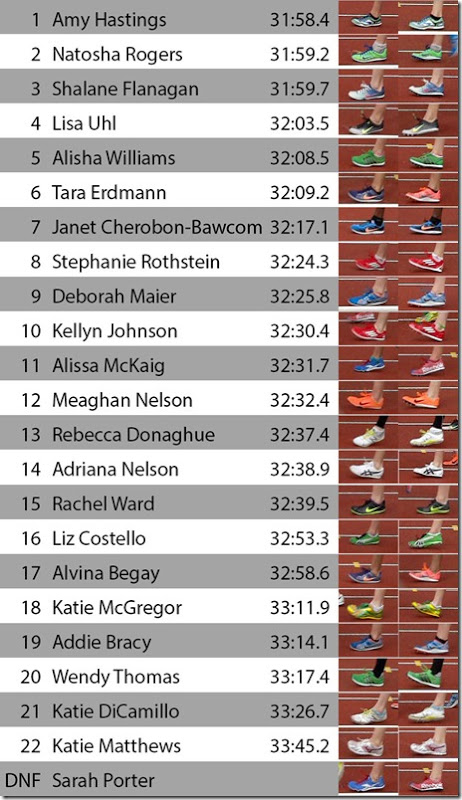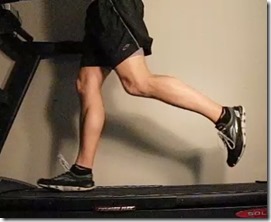A few days ago Steve Magness, assistant coach at the Nike Oregon Project, directed me to a couple of images that BYU biomechanist Iain Hunter had put together showing foot strikes of Men and Women at the US Olympic 10K trials. In case you have not seen them yet, I thought I’d share them here – quite a bit of variation even among these elites! Feel free to share any thoughts you have in the comments.
You can find the original high-resolution images produced by Hunter here:
Men’s US Olympic Trials 10K Images
Women’s US Olympic Trials 10K Images




















Pete, it would also have been interesting to see where their feet and knees were in relation to their center of gravity when they struck the ground. Based on some of the stuff in your book and watching the heel strikers, foot placement may be more important than the actual strike pattern.
I agree – very few of the heel strikes are similar to what I see among overstriding recreational runners.
—-
Pete Larson’s Web Links:
My book: Tread Lightly – link to ow.ly
Work: link to anselm.edu…
Blog: https://runblogger.com
Dailymile Profile: link to dailymile.com…
Twitter: link to twitter.com
Maybe the discussion really needs to be about over-striding instead of heel striking?
I would agree with that for the most part, there are some issues that foot strike can have bearing on though, and extremes in either direction are probably problematic. But, I think overstriding is the bigger issue for most. There is likely some correlation between stride length and foot strike too, important to keep that in mind.
—-
Pete Larson’s Web Links:
My book: Tread Lightly – link to ow.ly
Work: link to anselm.edu…
Blog: https://runblogger.com
Dailymile Profile: link to dailymile.com…
Twitter: link to twitter.com
1 of the top 10 is a heel striker and he’s number 9.
Like I wrote in the blog of Brian, it’s interesting to see that for male, in the first half, there is a lot
less heel striker (2) compare to the last half (6)… (same tendency for
female)… more your are in back of the pack, more we observe “more rear
foot striker (more positive angle between the foot and the ground) ”
Are they “more heel striker” juste because they run slower? … or, they run slower because they are less efficient?
Blaise
That’s the million dollar question.
I actually see two heelstrikers in the top 10 (Braun and Mack), but that’s splitting hairs and I don’t believe it’s one of the more important things to pull from this discussion.
Back in 2011, I remember seeing a lot of comments post-Boston about how Kilel, a forefoot striker, beat Davila, a heelstriker. Yet everyone seemed to ignore the fact that Davila beat every single female midfoot striker and all but one forefoot striker. I think it’s important to remember that these runners are all the cream of the crop. The biggest thing that I’m noticing are a variety of footstrikes among the top 10K runners in the nation. As 10K guys, I think it’s safe to say that these athletes are mixing high volume with intense track workouts, which should force them to develop an extremely efficient stride.
At that level, I don’t think minor variation in footstrike is all that important to separating one runner from another. None of these elites are even close to what I’ve seen a lot of recreational runners doing with overstriding gaits – I do wish I could see the entire leg from the hip down though.
—-
Pete Larson’s Web Links:
My book: Tread Lightly – link to ow.ly
Work: link to anselm.edu…
Blog: https://runblogger.com
Dailymile Profile: link to dailymile.com…
Twitter: link to twitter.com
Ditto that. Would love to see hip down. Here’s some stuff that may be of interest:
Hunter also got full body shots of the women’s 800:link to biomechanics.byu.edu…
More forefoot striking as we approach a sprint, versus the 10,000. That’s in line with what I’ve been guessing based on my own stride and the strides of other people I’ve observed. More importantly, they’re all landing slightly ahead of their COG, with a bent knee and a close to perpendicular tibia. No surprises there.
Women’s 5000, skip to 4:22, there are two slo-mo replays:
link to nbcolympics.com…
Watch D’Agostino (Dartmouth, in green), who I believe is known for her kick, and who made up a ton of ground on Lucas in the last 200m. Looong stride in those final steps. Could not tell you whether that’s her normal kick or if she’s just straining at the finish, but wow. Overstriding? By what most of us have assumed was the appearance of an overstride, I’d guess yes, and I would assume that if she did all of her running (rather than just her kicking) with that stride length, she’d be in trouble. But by the “ideal stride length for a given speed is whatever is most efficient, and anything smaller or larger is under/overstriding,” I don’t know. Can we really assume that a kicker hasn’t figured out their most efficient stride length for their kick? What’s your take?
Great video! I’d say that’s ding everything you possibly can to reach that finishline first – definitely not the form she’d use for the entire race. Painful to watch Lucas though, she had nothing left.
—-
Pete Larson’s Web Links:
My book: Tread Lightly – link to ow.ly
Work: link to anselm.edu…
Blog: https://runblogger.com
Dailymile Profile: link to dailymile.com…
Twitter: link to twitter.com
I’m interested in the whole overpronation correction aspect of running from looking at this. You hear so much about correcting overpronation from running shoe manufacturers, and the backlash from the minimal running community saying that it’s really not an issue. This is an elite group of runners, and in these shots some of them look like they’re about to roll an ankle. Makes me wonder about the whole thing.
Wrote an entire chapter on the overpronation issue in my book – I’m not a big believer in the idea that controlling “overpronation” should be a major factor in choosing a shoe.
—-
Pete Larson’s Web Links:
My book: Tread Lightly – link to ow.ly
Work: link to anselm.edu…
Blog: https://runblogger.com
Dailymile Profile: link to dailymile.com…
Twitter: link to twitter.com
The majority of the runners appear to be leading with their heels as well. It would be cool to see a long series of one runners striking patterns to see how consistent they are.
Anyone else notice the high number of heel strikers wearing Adidias shoes? Why is that?
I noticed that too – tough to say if there is any reason for it.
I made the same observation on the Sweat Science blog. I haven’t bought Adidas in about two years because most seemed to have about a 12mm. I haven’t looked at them recently, but that drop might be the reason. Some Nike flats also have quite a drop, and there are some major Nike heel strikes too.
In addition to some pretty tall heel-to-toe offsets, adidas and Nike tend to have quite narrow toe boxes. I avoid them, but the Nike Free Run isn’t too bad.
Oh, if we only had force plates under those feet to see what else was going on…
Quite apart the forefoot and heel striking I notice that the top 3 men and 2 of the top 3 women land way on the outside of their foot. Indication of speed? Sure looks like they may also be susceptible to ankle twists and other injuries.
It’s not mention too often in discussion about foot strike, but I think it’s worth raising. Tension of the muscles and tendons above the foot on landing look rather different across the range of foot strikes.
For the heavy heel strikers I can’t help but conclude that their shin muscles and tendons in front of the ankle are working hard to pull the foot up on landing. You can’t see it from the photo’s but I’d guess their shin muscles will all be tight in a pronounced way.
About a month ago I did some slow motion video capture of friend who had just started up running a year ago. He was over-striding and heel striking and this came out in the video footage, and looking at still captured from this video one can even see his shin muscles prior to and on landing being strongly activated.
I would guess that we’d see a similar activation in these elite 10k heel strikers too. While they performing at an exceptional level I can’t help but feel that they are wasting energy on muscle activation that doesn’t generate any useful locomotive force or benefit from any elastic recoil, and the risk of shin splits had to be increased.
On the other hand, a forefoot striker is undergoing a large amount of eccentric calf muscle contraction. At this level, I’d hypothesize that the vast majority of these athletes have already self-selected whatever stride is most efficient for their personal biomechanics.
I would agree to an extent. I’d be curious to know how much it might also be influenced by what shoes they use for the rather large number of training miles they run each week, what type of casual footwear they use, and how their form developed in childhood..
—-
Pete Larson’s Web Links:
My book: Tread Lightly – link to ow.ly
Work: link to anselm.edu…
Blog: https://runblogger.com
Dailymile Profile: link to dailymile.com…
Twitter: link to twitter.com
Their shoes influenced their selection and the problem with that is shoes change over time.
I’d put it this way. The runners have adapted to the way they habitually run. Each individual probably has the potential to run in many different styles but they do settle on a dominant one. It’s not necessarily the most efficient as other motivators could be compensation for a prior injury, muscular imbalances, and footwear choice. I’d rather have my calves bearing the load than my shins. The shin muscles are much smaller and the risk of anterior tibial stress fracture scares me. It’s easier to massage and roll out calf muscles than shin muscles. There’s the risk of Achilles problems, but I’m mindful about my form and I massage the knots out of my calves if any develop.
Well put!
—-
Pete Larson’s Web Links:
My book: Tread Lightly – link to ow.ly
Work: link to anselm.edu…
Blog: https://runblogger.com
Dailymile Profile: link to dailymile.com…
Twitter: link to twitter.com
I don’t see over-pronation in these photos. Some might be under-pronating.
-rovatti
You’d never see overpronation at the initial moment of contact. The foot is almost always supinated at contact.
—-
Pete Larson’s Web Links:
My book: Tread Lightly – link to ow.ly
Work: link to anselm.edu…
Blog: https://runblogger.com
Dailymile Profile: link to dailymile.com…
Twitter: link to twitter.com
Great post you guys! Thank you!